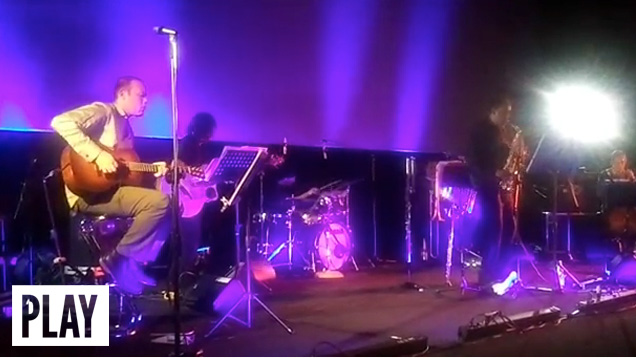NC
From early in your career you have been a sort of fellow traveler of the Association for the Advancement of Creative Musicians. Was that affinity more about the influence(s) of individuals — like Joseph Jarman and Leroy Jenkins, your band mates in Equal Interest — or have you also been drawn to the aims of the organization as a whole?
The first concert I ever heard by a member of the AACM was in Olympia, WA when I was student at the Evergreen State College. I had just switched my major from environmental science to music and had begun taking jazz piano lessons. That concert by Leroy Jenkins, Amina Claudine Myers and Pheeroan Ak Laff, made a huge impact on me. On one level, I didn’t get the music, it was unlike anything I’d ever heard before, but on another level I suddenly knew that this was what I wanted to do with my life, to discover and pursue my own music.
To that end, the AACM, as an artistic collective with the mission (in part) to foster each individual member’s musical voice, was enormously inspiring to me. In addition, I’ve had the great fortune to study and work with several members of the organization. I took composition lessons with Henry Threadgill in the late 80s, and to this day I would still count him as my most important mentor in that area. I did a workshop, as a student, with Leroy Jenkins where I met Brandon Ross and other musicians I’ve gone on to work with. I studied aikido and Zen meditation with Joseph Jarman, and those practices have contributed greatly to my development as a musician.
In more recent years, I’ve had the privilege of performing with both Nicole Mitchell, and Roscoe Mitchell, and have experienced a closer a kinship with Muhal Richard Abrams as a pianist, mentor and philosopher. George Lewis has been an important mentor, as well, not only as a musician, but also as a professor of music, he encouraged me to pursue that aspect of my career. Of course, I have been drawn to and inspired by the socio-political aims of the organization, as well, but the more personal connection is to the sense of artistic freedom to chart one’s own course as a creative being and their support for a multiplicity of approaches to making music.
NC
You mentioned Henry Threadgill's compositional mentorship, which raises the question: what are the concepts and techniques of his that you still incorporate?
Henry suggested the idea that a piece of music would grow naturally from an initial idea, and that I didn’t need to impose content or form that didn’t evolve on its own. This idea jibed perfectly with the building philosophy of architect Frank Lloyd Wright, who designed the house in which I grew up in Glencoe, IL. Like Wright, Henry thought of the creation of his work as an organic process and offered many ways of developing that initial idea as well as approaches for how to incorporate the numerous, ensuing permutations in ways that might not readily be apparent. He also encouraged me to use the material from the piece to inform the improvisation in ways other than the more conventional jazz model of chord-scale or motivic development. For instance, he suggested I mine the piece for characteristic phrases, intervals, rhythms, and to get those into my hands/ears, so they become the point of departure, rather than imposing habitual modes of playing. His current ensemble, Zooid, is a brilliant example of this philosophy and a continual inspiration to me.
Aural Space:
Growing up in a beautiful architectural space in which one room flowed into the next, and the outdoors blended seamlessly with the interior, also had a profound impact on my eventual direction as a composer/improviser. I think it was the beginning of my appreciation for the concept that structure needn’t be confining. In fact, it could offer just the opposite experience.
I had a similarly transforming experience while visiting the mosque, La Mezquita, in Cordoba, Spain.

La Mezquita- Córdoba, Spain
“…as soon as I entered, I felt like a different person. This experience kindled an aspiration for me as a musician: to create an aural space…that is not only structurally and esthetically satisfying, but that also allows for the individual listener or player within it to have her own experience – an experience that perhaps leaves one feeling alone, but that brings one back to one’s Self, that affirms one’s deepest feelings or longing.”
Myra Melford
NC
Poetry — especially devotional work by Rumi and others — has also been an obvious source of inspiration for you. Do you respond to poetic rhythm (i.e., cadence) as strongly as you do to imagery and language?
It varies. Recently, I’ve been more responsive to imagery and metaphor, particularly in the poetry of Rumi, but historically in the poetry of Fernando Pessoa who inspired “Even the Sounds Shine.” Rumi and other mystic poets so beautifully evoke the goal of my spiritual and musical practice—that of union and connection. I’m continually trying to get to that place when I compose and perform, and it’s that, that I aspire to share with my audience and fellow ensemble members. But I’ve also been inspired by the cadences and language of James Joyce, especially in my early work for trio and the Extended Ensemble. Pieces like “and Silence,” “That the Peace,” and “Evening Might Still,” as well as some of vocabulary as a pianist, were inspired by The Portrait of the Artist as a Young Man. I can’t really say it’s just the imagery or the rhythm or the language, it’s a kind recognition or resonance with the speaker and what’s being spoken, as I understand it that inspires me.




